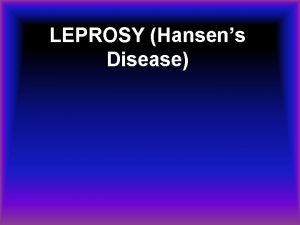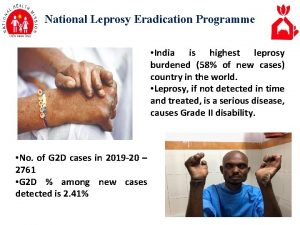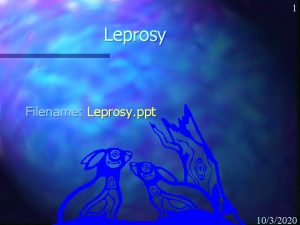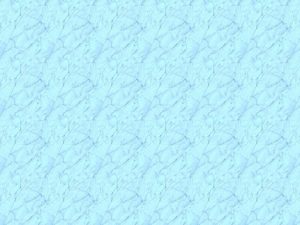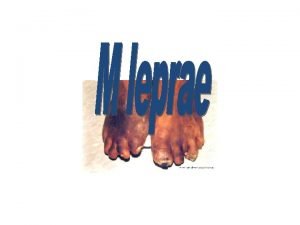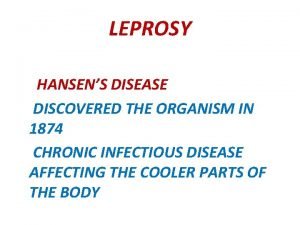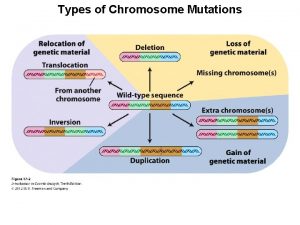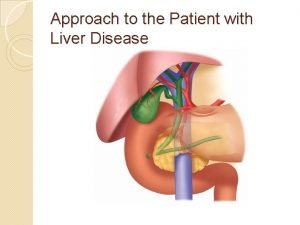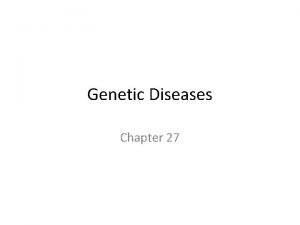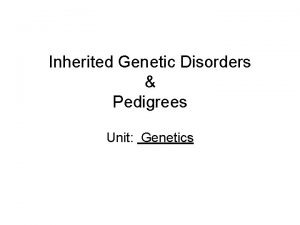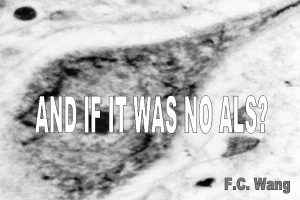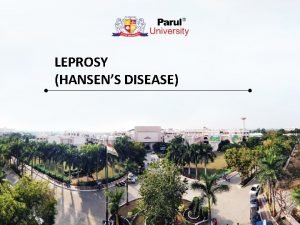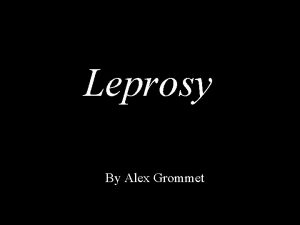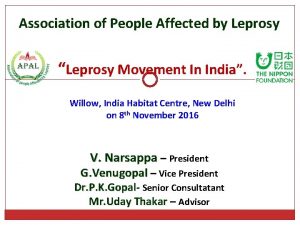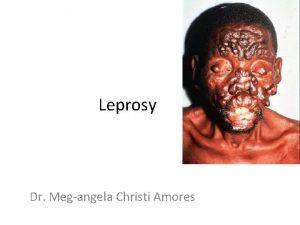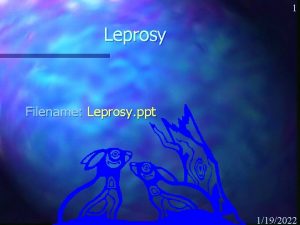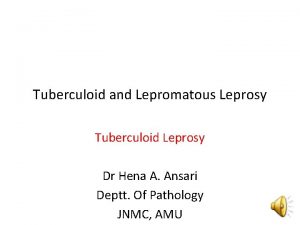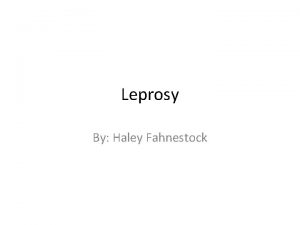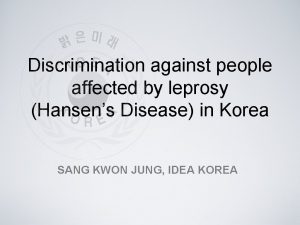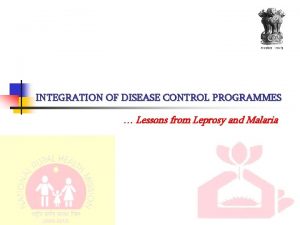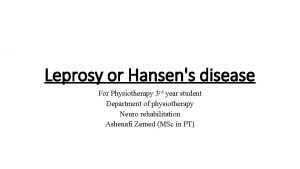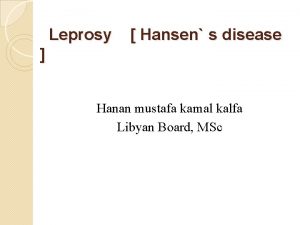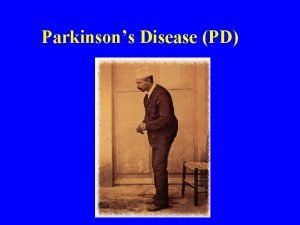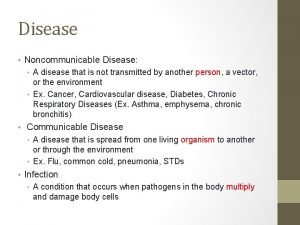Module 1 LEPROSY The Disease WHAT IS LEPROSY


































































- Slides: 66

Module 1: LEPROSY: The Disease

WHAT IS LEPROSY? Leprosy is a chronic infectious disease caused by Mycobacterium leprae, an acid-fast, rod-shaped bacillus that mainly affects the skin, peripheral nerves, mucosa of the upper respiratory tract and eyes.

It has a very long incubation period or latency which ranges from 3 to 15 years.

• Leprosy is an infectious disease directly transmitted from man to man. • It is acquired through prolonged repeated exposure & chromo 6 • It is transmitted from one untreated person to another via the respiratory tract. • Only a small proportion of the population is affected (5%); (95%) develop immunity.

DIAGNOSIS OF LEPROSY: Diagnosis of leprosy is mainly based on clinical signs and symptoms. Only in rare instances is there a need to use laboratory and other investigations to confirm a diagnosis of leprosy.

An individual should be regarded as having leprosy if he exhibits the following cardinal signs: q Hypo-pigmented or reddish skin lesion(s) with definite sensory loss; q Peripheral nerve damage, as demonstrated by loss of sensation and muscle weakness in the hands, feet and/ or face; q Positive skin smear.

Other signs of leprosy are: q Skin lesion(s) with a decrease or loss of sweating and/or hair growth;

Other signs of leprosy are: q Skin lesion(s) with a decrease or loss of sweating and/or hair growth; q Constant redness in the eyes from irritation and dryness;

Other signs of leprosy are: q Skin lesion(s) with a decrease or loss of sweating and/or hair growth; q Constant redness in the eyes from irritation and dryness; q Loss of eyebrows and eyelashes (madarosis);

Other signs of leprosy are: q Skin lesion(s) with a decrease or loss of sweating and/or hair growth; q Constant redness in the eyes from irritation and dryness; q Loss of eyebrows and eyelashes (madarosis);

Other signs of leprosy are: q Nasal congestion / obstruction and frequent nosebleed q Collapse of nose bridge;

Other signs of leprosy are: q Enlargement of the breast in males (gynecomastia);

Other signs of leprosy are: q Mobile or stiff clawing of fingers and toes

Other signs of leprosy are: q Chronic ulcers, usually in the sole of the foot, palm of the hands and fingers.

Diagnosis of leprosy is mainly based on clinical signs and symptoms. i

The development of complications can be effectively prevented through early detection, correct diagnosis and effective treatment. i

PATIENT’S HISTORY: The leprosy case history should have the following information: 1. The nature of the first lesion or symptom and its progress. This is because the skin lesion usually develops slowly over several months and is not troublesome.

Ask: • When did the patient first notice the lesion? • What was its appearance? • How did it feel? Was it painful? Itchy? ?

PATIENT’S HISTORY: 2. Past Treatment. ? Ask: • What did the patient do when he first noticed the lesion? • Did he apply any drug(s)? • What was the effect of this/these drug(s)?

PATIENT’S HISTORY: 3. Other Illnesses. Pay attention to contra-indications to MDT drugs; or any other illness requiring special attention and/or referral.

Ask: • Does the patient have a history of liver disease? • Allergy to drugs? • If yes, what drugs? ?

PATIENT’S HISTORY: 4. Contact with Persons With Leprosy (PWLs) This information will help determine the patient’s susceptibility to the disease.

Ask: • Does/did anyone in the family have leprosy? • Does he have a friend or acquaintance who has/had leprosy? ?

CLASSIFICATION: Leprosy can be classified on the basis of clinical manifestations and skin smear results. The Ridley-Jopling classification has seven (7) types of leprosy:

CLASSIFICATION: (Ridley-Jopling) 1. Indeterminate (I). Solitary, ill-defined, faintly hypopigmented macule, with partial loss of sensation.

CLASSIFICATION: (Ridley-Jopling) 1. Indeterminate (I) Solitary, ill-defined hypopigmented macule on left cheek; only partially anesthetic.

CLASSIFICATION: (Ridley-Jopling) 1. Indeterminate (I) Solitary, ill-defined, faintly hypopigmented macule on the dorsum of the wrist; minimal surface changes; partially

CLASSIFICATION: (Ridley-Jopling) 1. Indeterminate (I) Single, slightly hypochromic macule with illdefine borders on the dorsum of the lower right forearm; minimal surface changes; partially

CLASSIFICATION: (Ridley-Jopling) 2. Tuberculoid (TT) Small, solitary marginally hypopigmented oval lesion, with papulated welldefined margins with flat, slightly atrophic central area insensitive to

CLASSIFICATION: (Ridley-Jopling) 2. Tuberculoid (TT) Faintly hypochromic, rounded macule with discontinuously papulate borders, fairly defined, anesthetic, above smallpox

CLASSIFICATION: (Ridley-Jopling) 2. Tuberculoid (TT) Solitary, welldefined early tuberculoid lesion with slightly papulate borders; completely

CLASSIFICATION: (Ridley-Jopling) 2. Tuberculoid (TT) Sharp-edged, hypopigmented, ringworm-like lesion with finely papulate borders; anesthetic.

CLASSIFICATION: (Ridley-Jopling) 2. Tuberculoid (TT) Superficial, circinate lesion with pinkish, elevated, finely granular margins; center is insensitive to touch and pain.

CLASSIFICATION: (Ridley-Jopling) 2. Tuberculoid (TT) Well-defined, hypopigmented lesion with dry surface and moderately raised granular margins; completely

CLASSIFICATION: (Ridley-Jopling) 3. Borderline Tuberculoid (BT) Rounded lesion with wide, slightly brownish and scaly elevated margins fairly well-defined, center flat, with noticeable hair loss; at posterior aspect of the leg;

CLASSIFICATION: (Ridley-Jopling) 3. Borderline Tuberculoid (BT) One of several sharp-edged, erythematous patches on the patient, with fairly thick granular margins and small satellite lesions;

CLASSIFICATION: (Ridley-Jopling) 3. Borderline Tuberculoid (BT) Well-defined, dry and rough surfaced plaque on cheek, insensitive to touch and pain; note papulo-nodular lesions near eye

CLASSIFICATION: (Ridley-Jopling) 3. Borderline Tuberculoid (BT) Distinct, erythemato - hypochromic patch with a dry surface and raised, well defined margins showing satellite lesions; anesthetic.

CLASSIFICATION: (Ridley-Jopling) 3. Borderline Tuberculoid (BT) Large patch with wide, raised erythematous welldefined margins sloping toward center of lesion; central portion is

CLASSIFICATION: (Ridley-Jopling) 3. Borderline Tuberculoid (BT) Multiple, sharplydemarcated, scaly reddish-brown plaques; these subsiding lesions are only partially anesthetic.

CLASSIFICATION: (Ridley-Jopling) 3. Borderline Tuberculoid (BT) Large, thickly infiltrated, sharpedged plaque with slightly scaling surface; anesthetic.

CLASSIFICATION: (Ridley-Jopling) 3. Borderline Tuberculoid (BT) Extensive, subsiding lesions showing large, clear center areas surrounded by welldefined, slightly raised, inner and outer margins;

CLASSIFICATION: (Ridley-Jopling) 4. Borderline (BB) Fairly extensive succulent plaque with sharply demarcated clear central area; peripheral edges sloping into surrounding normal skin; central

CLASSIFICATION: (Ridley-Jopling) 4. Borderline (BB) Several “punchedout” lesions very characteristic of borderline leprosy; central areas are anesthetic.

CLASSIFICATION: (Ridley-Jopling) 4. Borderline (BB) Irregular, erythematous, infiltrated bands around a large, anesthetic central “immune” area; inner margins of lesion tend to be

CLASSIFICATION: (Ridley-Jopling) 4. Borderline (BB) Classical “punchedout” lesions of borderline leprosy; central “immune” areas are anesthetic.

CLASSIFICATION: (Ridley-Jopling) 5. Borderline Lepromatous (BL) Numerous and widespread borderline-type plaques, annular lesions, papules and macules; center of large lesions show some loss of

CLASSIFICATION: (Ridley-Jopling) 5. Borderline Lepromatous (BL) Thick, erythematous plaques on face and ears. Lesions are not sharply defined and show no sensory impairment.

CLASSIFICATION: (Ridley-Jopling) 5. Borderline Lepromatous (BL) Bilaterally distributed, irregularly shaped, erythematous, infiltrated patches; these are not

CLASSIFICATION: (Ridley-Jopling) 5. Borderline Lepromatous (BL) Fairly uniform symmetrically distributed, infiltrated, maculopapular lesions, none of which show sensory impairment.

CLASSIFICATION: (Ridley-Jopling) 6. Sub-polar Lepromatous (LLs) Symmetrically distributed infiltration with prominent macular lesions. Note borderline-type, punched-out patches on the wrist.

CLASSIFICATION: (Ridley-Jopling) 6. Sub-polar Lepromatous (LLs) Symmetrical infiltration and erythematous macules, with an unusual borderlinetype plaque on the left buttock.

CLASSIFICATION: (Ridley-Jopling) 6. Sub-polar Lepromatous (LLs) Extensive, symmetrically distributed infiltration with almost coalescent macules and plaques. These lesions are not anesthetic. Note small rounded borderline-type plaque on the left lumbar

CLASSIFICATION: (Ridley-Jopling) 7. Polar Lepromatous (LLp) Early lepromatous leprosy with recognizable diffuse infiltration all over face and ears.

CLASSIFICATION: (Ridley-Jopling) 7. Polar Lepromatous (LLp) Fairly advanced lepromatous leprosy, with symmetrically distributed diffuse infiltration, nodules on face and ears, and madarosis.

CLASSIFICATION: (Ridley-Jopling) 7. Polar Lepromatous (LLp) Advanced lepromatous leprosy, with marked diffuse infiltration, madarosis and loss

CLASSIFICATION: (Ridley-Jopling) 7. Polar Lepromatous (LLp) Advanced lepromatous leprosy with diffuse infiltration coupled with nodules over eyebrows, cheeks, ala nasae and chin, as well as earlobes.

CLASSIFICATION: (Ridley-Jopling) 7. Polar Lepromatous (LLp) Advanced lepromatous leprosy with diffuse infiltration and nodular lesions.

The World Health Organization (WHO) classifies leprosy into only three (3) types: • Single Lesion Paucibacillary (SLPB) • Paucibacillary (PB) • Multibacillary (MB)

CLASSIFICATION: Characteristic SLPB PB MB Lesions: • Type Macule Infiltrated patches Macules, plaques, papules & infiltration

CLASSIFICATION: Characteristic SLPB PB MB Lesions: • Number One (1) Two (2) to five (5) More than five (>5)

CLASSIFICATION: Characteristic SLPB PB MB Normal, dry or scaly, absence of hair growth Smooth & shiny, some lesions may be dry Lesions: • Surface Normal, dry or scaly

CLASSIFICATION: Characteristic SLPB PB MB Lesions: • Border ill-defined to welldefined Welldefined, clear-cut margins Vague, sloping outwards, merges impercepti bly with surroundin g skin

CLASSIFICATION: Characteristic SLPB None Nerve Involvement: PB Zero (0) to one (1) MB More than one (1)

CLASSIFICATION: Characteristic Slit Skin Smear: SLPB Negative MB Positive NOTE: Positive skin smear = Multibacillary (MB) regimen.

 Leprosy disease
Leprosy disease National leprosy eradication programme ppt
National leprosy eradication programme ppt Defination of leprosy
Defination of leprosy Leprosy ppt 2020
Leprosy ppt 2020 Leprosy
Leprosy Histoid leprosy ppt
Histoid leprosy ppt Lessons from naaman
Lessons from naaman Eryhtema nodosum
Eryhtema nodosum Four men with leprosy
Four men with leprosy Lepra fotos enfermos
Lepra fotos enfermos Communicable disease and non communicable disease
Communicable disease and non communicable disease C device module module 1
C device module module 1 Môn thể thao bắt đầu bằng từ đua
Môn thể thao bắt đầu bằng từ đua Sự nuôi và dạy con của hổ
Sự nuôi và dạy con của hổ điện thế nghỉ
điện thế nghỉ Thế nào là sự mỏi cơ
Thế nào là sự mỏi cơ Trời xanh đây là của chúng ta thể thơ
Trời xanh đây là của chúng ta thể thơ Gấu đi như thế nào
Gấu đi như thế nào Thiếu nhi thế giới liên hoan
Thiếu nhi thế giới liên hoan Các số nguyên tố là gì
Các số nguyên tố là gì Fecboak
Fecboak Các châu lục và đại dương trên thế giới
Các châu lục và đại dương trên thế giới Một số thể thơ truyền thống
Một số thể thơ truyền thống Thế nào là hệ số cao nhất
Thế nào là hệ số cao nhất Sơ đồ cơ thể người
Sơ đồ cơ thể người Tư thế ngồi viết
Tư thế ngồi viết Hát kết hợp bộ gõ cơ thể
Hát kết hợp bộ gõ cơ thể đặc điểm cơ thể của người tối cổ
đặc điểm cơ thể của người tối cổ Mật thư tọa độ 5x5
Mật thư tọa độ 5x5 Glasgow thang điểm
Glasgow thang điểm ưu thế lai là gì
ưu thế lai là gì Thẻ vin
Thẻ vin Thể thơ truyền thống
Thể thơ truyền thống Cái miệng nó xinh thế
Cái miệng nó xinh thế Các châu lục và đại dương trên thế giới
Các châu lục và đại dương trên thế giới Từ ngữ thể hiện lòng nhân hậu
Từ ngữ thể hiện lòng nhân hậu Diễn thế sinh thái là
Diễn thế sinh thái là Tư thế ngồi viết
Tư thế ngồi viết Frameset trong html5
Frameset trong html5 Ví dụ về giọng cùng tên
Ví dụ về giọng cùng tên 101012 bằng
101012 bằng Hát lên người ơi
Hát lên người ơi Hươu thường đẻ mỗi lứa mấy con
Hươu thường đẻ mỗi lứa mấy con đại từ thay thế
đại từ thay thế Quá trình desamine hóa có thể tạo ra
Quá trình desamine hóa có thể tạo ra Vẽ hình chiếu vuông góc của vật thể sau
Vẽ hình chiếu vuông góc của vật thể sau Công thức tính độ biến thiên đông lượng
Công thức tính độ biến thiên đông lượng Tỉ lệ cơ thể trẻ em
Tỉ lệ cơ thể trẻ em Thế nào là mạng điện lắp đặt kiểu nổi
Thế nào là mạng điện lắp đặt kiểu nổi Dot
Dot Lời thề hippocrates
Lời thề hippocrates Bổ thể
Bổ thể Vẽ hình chiếu đứng bằng cạnh của vật thể
Vẽ hình chiếu đứng bằng cạnh của vật thể Phản ứng thế ankan
Phản ứng thế ankan Granulomatous uveitis
Granulomatous uveitis Turner syndrome
Turner syndrome Stigmata of chronic liver disease
Stigmata of chronic liver disease Peripheral arterial disease
Peripheral arterial disease Vwf deficiency labs
Vwf deficiency labs Mb hirschsprung
Mb hirschsprung Obstructive vs restrictive lung disease
Obstructive vs restrictive lung disease Tasax disease
Tasax disease Dyesthesiasis
Dyesthesiasis Hd disease
Hd disease Basal ganglia
Basal ganglia Als disease
Als disease The good physician treats the disease
The good physician treats the disease
